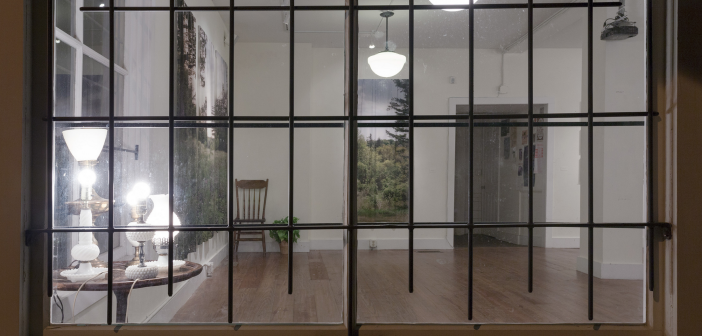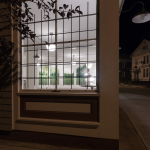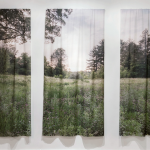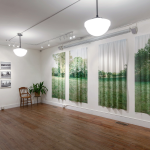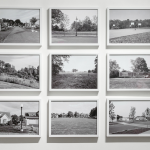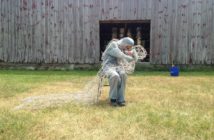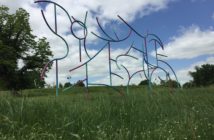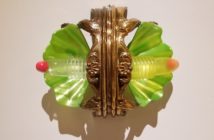Jodie Mim Goodnough is a Providence-based artist who uses photography, video, performance and sculpture to examine the various coping strategies we employ to find comfort in an often uncomfortable world, from religious rituals to pharmaceuticals and everything in between. She attended the photojournalism program at the Salt Institute for Documentary Studies in Portland, Maine and received her MFA from the School of the Museum of Fine Arts, Boston in May 2013. Sandra Erbacher spoke with Goodnough about her photographic process and research into mental illness, landscape, and politics on the occasion of her recent solo exhibition Prospect at 186 Carpenter in Providence.
Sandra Erbacher: Can you tell me about your current show at 186 Carpenter and how it relates to your previous work?
Jodie Goodnough: Prospect is a new series focusing on the sites of late 19th and early 20th century mental hospitals, the types of large-scale asylums we typically see represented in movies and on television. It consists of two series—vertical landscape photographs printed on fabric and smaller, traditional black and white photographs framed and hung in a grid. The landscapes depict the views patients would have seen from these hospitals during their time, or as close as I could get to what that would look like given our ever-changing landscape. The black and white photographs show the modern use of these sites—luxury residential developments. This project emerged directly out of my last series, A Curious Dance, shown at GRIN in February. That project focused on a series of gesture drawings of female patients in a Victorian asylum in France, using contemporary dancers to recreate their movements for the camera. While doing research for that project I came across an influential text written by Dr. Thomas Kirkbride, describing in great detail his ideal asylum—one with pastoral views, gardens for walking, abundant sunlight and fresh air. His plans became the basis for the majority of the mental hospitals built in the second half of the 19th century, and are the iconic asylum type used in movies like One Flew Over the Cuckoo’s Nest and Girl, Interrupted. I was struck by the vast difference between the ideal asylum that Kirkbride imagined and the sad reality of what his buildings became. I also couldn’t help but think about the differences between his ideal asylum and today’s mental hospitals, which is also vast.
SE: Formally, there has been an expansion in your practice beyond the framed photograph. You now incorporate video, sound, sculpture and installation in a fluid and contemporary way. In this current show, for instance, you have printed your large format photographs on fabric and they are hung like curtains from the wall. Can you tell us about the motivation behind this general shift?
JG: It’s true, I’ve been slowly pushing away from the traditional photograph for some time now. Variants, my graduate thesis project, was the beginning of that trend. For that project, I shot a traditional portrait series of psychiatric patients, but presented one set of photographs at 4 x 5” hung on clipboards, and exhibited the other set on a video monitor, with each photograph appearing for 15 seconds, the length of a short commercial. I think, generally speaking, the shift comes out of a long-standing love of installation work, and the desire for the materials I work with to connect to the ideas I’m exploring. I’ve always wanted to create an experience for the viewer that engages them beyond simply looking, but I think it’s taken me a while to find ways to do so that feel true to me, and aren’t me simply aping someone else’s aesthetic. The “curtains” were really exciting for me. The size of the fabric was taken from Thomas Kirkbride's description of the ideal window size for his institutions: 36 x 78 inches. I’m always going to be an image-maker. It’s what I do. But printing the photographs on fabric allowed me to play with other elements, like air movement and translucency, that have opened up a number of new possibilities for the future development of this project.
SE: The key tropes recurring in your work and research are mental illness, loss and memory. This particular body of work signals a thematic shift of focus from the architecture of mental illness and the body towards landscape, society and politics, a shift from the interior to the exterior. What has sparked this recent development, which is symbolized by the camera’s point of view looking through the windows and into the surrounding landscape?
JG: That’s a great question, actually. There is definitely a political and economic subtext to the work that’s more visible in this project than it has been in the past. I try to stay away from work that screams activism, but I can’t help but have strong feelings about our current mental health system, as it’s affected my life and the lives of many of my friends and family members. It’s a system that is deeply flawed, not the least of which is that it’s nearly impossible for a low-income person to receive quality mental health care. These grand asylums I’m fairly obsessed with weren’t built for the rich—they were public hospitals created in the spirit of what was called Moral Treatment, based on Quaker principles. Although they became something far removed from the peaceful places they were supposed to be, I keep coming back to the ideals they were created to serve—respectful treatment of the mentally ill in a beautiful setting, designed to facilitate contact with the natural world. It’s this emphasis on the natural world that really resonated with me personally. I’ve always found the outdoors to be therapeutic, and one of my favourite early snapshots from my childhood is of my mother and I hiking in the woods together. The divorcing of environment from mental health seems strange to me—who isn’t affected by their location and surroundings?
SE: The presented landscape in Prospect is at a first glance peaceful and unspoilt, recalling the art-historical tradition of the pastoral landscape of romanticism. The setting sun in particular brings to mind the quiet contemplation and spirituality associated with the work of Caspar David Friedrich. What role does landscape play in this body of work and what is the function of this very specific way of framing and presenting landscape?
JG: I thought a lot about the idea of the “ideal landscape” while shooting this project—something that Friedrich and his contemporaries were well versed in. It’s also something that is studied by evolutionary psychologists today, and taken into account in the field of biophilic design. It’s something that I now think about every time I look out a window, to be honest. There are aspects of a landscape that studies show make it more soothing to us as humans, including prospect (a view from above, such as on a hill), refuge (greenery or other element to hide behind) and mystery (something beyond the view, around a corner, etc), as well as small signs of human activity. I was conscious of all of these while shooting the landscapes in Prospect. As for the late afternoon/evening light, it’s definitely a nod to Romanticism. I’m aware that the way I’m looking at these sites, buildings and their history is with an unrealistic, romantic slant, and so I pushed that feeling while shooting the work.
SE: You mentioned previously that you collect lamps and that they have become a recurring motif/object in your work? What is their significance for you in general and in the context of this show?
JG: It’s a recurring motif that I didn’t notice for a long time. When I was in graduate school I spent a lot of time shooting photographs in and around my parents’ apartment. My father was dying and I wanted to document the way the space changed as he went from living at home to living in the nursing home and finally passing away. I look back at those photos and the lamps are front and center. They became a symbol for me, the presence of someone not physically there, a feeling of warmth and home. They are the opposite of institutional. Later I read Poetics of Space by Bachelard and was taken by his description of viewing a home from outside, and being drawn to the light in the window. Todd Hido’s photographs capture this feeling well. The light of the lamp functions as a signifier of home, and of care I suppose.
SE: Can you tell me more about the framed black and white photographs in this installation, their content, your choice of black and white in contrast to the color prints on fabric and their more traditional framing and display in a grid?
JG: Those photos could be seen as a holdover from my more traditional photographic ways, but I included them as a purposeful contrast to the romanticism of the fabric pieces. The images consciously reference the New Topographics work in form and style, and depict the contemporary housing developments built on the sites of these former hospitals. What struck me on visiting the sites was just how uniform they all were. Each housing development looks like every other, and I felt that came across best in this format. The photos are not named individually, but as a group entitled Unbeatable Locations, taken from the promotional literature from one of the townhouse complexes.
SE: What’s next for you?
JG: There are a few next steps for me, actually. I want to keep visiting and shooting the locations of these hospitals. I feel that there is more to be done with the large fabric pieces, they might come even further off of the wall. But I'm also studying the plans for the buildings themselves and the surrounding landscaping—often designed by people like Olmsted—and creating my own plans for imaginary institutions based on my research. I've been practicing working with architectural drafting tools and hope to make cyanotypes out of the drawings when I'm finished. I'll also continue my research into biophilic design and therapeutic landscapes, but focus more on man-made gardens and their institutional applications. We're moving towards a time when we'll have very little unspoiled nature left, and psychologists are already studying the most effective types of artificial and planned nature features to replicate the natural spaces we are losing.
- Prospect, Installation at 186 Carpenter St., Providence, RI Image © Jodie Goodnough
- Northampton State Hospital from Prospect Three Inkjet Prints on Cotton Lawn, 36″x78″
- Prospect, Installation at 186 Carpenter St., Providence, RI Image © Jodie Goodnough
- Prospect, Installation at 186 Carpenter St., Providence, RI Image © Jodie Goodnough
- Unbeatable Locations from Prospect Nine Archival Inkjet Prints, 11.75″x15.75″

